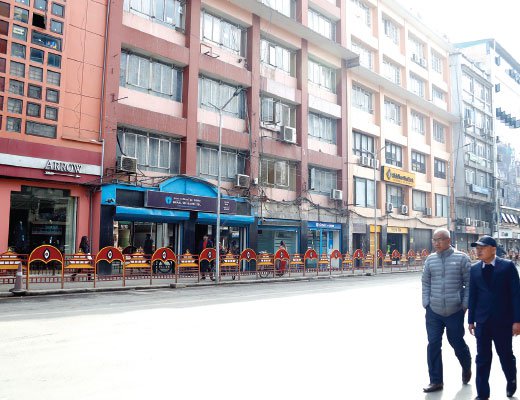
Recently, the Kathmandu Metropolitan City (KMC) has banned the parking of vehicles on the dirt roads of the New Road area. As an alternative to the current parking facilities, KMC has said that it will provide free parking facilities at Kathmandu Tower.
The head of KMC Municipality informed that 300 four-wheeled and 700 two-wheeled vehicles can be parked at Kathmandu Tower.
The new provision is expected to ease traffic in the area. He said that parking will be prohibited on the black topped roads around Dharmapath, Indra Chowk, Khichapokhari, Mahabaudh, Bir Hospital. Earlier, KMC had imposed a similar ban on vehicle parking in Jhonche area as well. He said that the removal of parking will have a negative impact on the business, which is gradually getting tight due to the corona pandemic and lockdown in the past.
It is said that if there is a law that prohibits parking on the road and black topped, then it seems that such law should be reviewed and amended in time. Senior citizens, differently abled people should have "Shuttle" service in Pashupati and other areas to go to the new road from Kathmandu Tower or other places.
In the past, there was also a discussion about the parking prohibition of Durbar Marg, saying that there is a demand of the businessmen to have one line of parking according to the agreement reached in the past with the Traffic Police, Road Department and Kathmandu Metropolitan City.
Did you know that a commuter in New Delhi spends more than 80 hours a year searching for a parking space? The problem of parking in Nepal is also increasing every year. The problem is simple – despite the increase in the number of vehicles, the parking space in Nepali cities has stagnated or decreased significantly due to the growing population.
Especially when land is limited and expensive, as in metros, sub-metropolises, municipalities, increasing parking demand places great pressure on it.
Parking problem in Nepal
Due to rapid economic and population growth, Nepalese metropolises, sub-metropolises are facing mobility crisis. Today, urban areas face great pressure on parking spaces, resulting in parking problems in Nepal such as traffic congestion, uneven demand and supply, and environmental hazards.
Due to poor parking management and policies, Nepal is struggling with chaotic conditions such as congested sidewalks, illegal parking, and criminal activities due to improper surveillance.
Let's take a look at some of the most pressing parking problems faced by metros in Nepal.
Parking Problems in Nepal
One of the most common problems today is the acute shortage of parking spaces. Prohibiting parking spaces without providing adequate alternatives may lead to social opposition Most cities propose increasing parking spaces to combat the problem. Parks and vacant lots are used as potential parking spaces and multi-level facilities are being built, despite limited land and resources.
Many smart cities in neighboring India are gradually using technology as a set of interventions to solve their parking problems, an encouraging development for mobility and parking problems in urban India.
Parking challenges
It began with the invention of the first automobile. However, as the process of population expansion and urbanization progressed, it became more and more. There have been more innovations to solve these parking challenges. The basic concept that creates parking challenges is the gap between parking demand and parking supply in urban areas and cities.
A deeper look into these issues reveals that these challenges arise not from lack of parking space but from inability to utilize available spaces. Solving these problems requires smart solutions and technological innovations.
Challenges
Many challenges affect parking management; Some have always existed, while others have sprung up as a result of the increase in the number of vehicles. Many historic and old cities were planned when cars never existed. This meant that the roads were narrow and not enough space for the number of vehicles, motor cycles we have today.
It is not an exaggeration to say that the government's main source of revenue is the import of more vehicles. The population density of these cities was at a reasonable level compared to now.
As the population grew and cars became available, these roads could no longer accommodate vehicles for parking and commuting. As a result, vehicles have exceeded planned capacities.
More facilities and activities are spread in the same area. More activities are taking place in places where commercial facilities, government institutions, and government buildings are located, which means an increased rate of vehicles in the same area, creating congestion problems.
In most newly planned urban areas and cities, the estimation of parking demand is often misjudged. This is due to the rapid increase in the rate of vehicle ownership, especially among the middle and high income segments of the population.
Due to increasing car ownership, these new areas have a faulty mass transit system, which these categories of people cannot depend on. It seems that there is a lot of problem in parking because 90 percent of the time in the metropolitan city area, the vehicle is parked and the remaining 5 percent of the time is driven on the road.
In addition, since the employees' cars of the service providers occupy almost 100% of the parking area, such offices should run "employee minibuses" (because the employees stay in the office all day and it is necessary to respect the customers and have parking arrangements.
While some periods do not require more residential vehicles, other periods are set up to welcome more commercial vehicles, affecting planning for parking management. Violations of zoning regulations and building codes alter the plans laid out by building planners for adequate parking spaces. Solution
Recent studies have shown that the growing challenges in current parking management are not due to lack of space. With new innovations, drivers can now easily access parking space availability information from their smartphones.
The parking management industry continues to evolve as many cities are plagued by traffic congestion and the unavailability of accessible parking. While there are more innovations for parking, there is still more room for technological advancements to solve the parking problem.
A mix of current and future will be key to a long-term solution to parking challenges. Some of the innovations in the parking industry include: Automated parking lots .
Many parking lots around the world are using automated systems, and this has proven to be a great innovation for parking management. The process involves improving space in parking lots by using machinery in the car parking process.
The import of vehicles, which is the main source of revenue, has also made this problem more difficult. Everyone has felt that the road is getting narrower as new vehicles are added every year. The first priority of every elected representative is the development of transportation. However, the development of this area has not been as it should be. The increase in the number of vehicles is more than 205 percent annually. In that ratio, neither the development of the road network, nor the improvement in management.
- Do Not Talk Too Much Negatively About Nepal!-Success Or Failure Of Nepal: Is It An Economic Problem? -
- Jun 23, 2024
- A Lot Of Heat Day In Nepal!!! Or Has The Summer Temperature Broken The Record So Far?
- Jun 03, 2024
- Nepal's 2081/82 Policy and Programme, Parliament Obstacles:Some Perspectives
- May 16, 2024
- Impact Of Indian Elections In Nepal
- May 03, 2024
- A Review Of The Handwritten “Gita Saar” Written By Krishna Prasad Lacoul In 1967-68 B.S.
- Apr 19, 2024

















